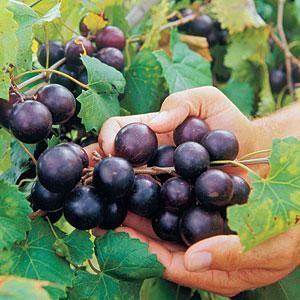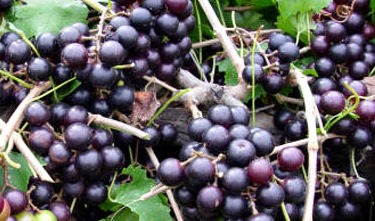An interview with Dr. Patricia Gallagher, Wake Forest University School of Medicine
Edited from an article by Xiaonan Shi (M.S.), Small Fruits Research and Extension Group, Department of Horticultural Science, NC State University and Mark Hoffmann, Small Fruits Extension Specialist, Department of Horticultural Science, NC State University, published in the Small Fruit News Program News, June 10, 2020
Introduction
The high antioxidant capacity of muscadine grapes may potentially be beneficial to human health if included in a regular diet. Due to this potential health benefit, the production and sale of muscadine based nutraceuticals products has grown over the past decade to a multi-million dollar industry. However, questions remain as to whether muscadine-based products can also be used as a medical treatment for cancer or cardiovascular diseases.
Dr. Patricia Gallagher and her team at Wake Forest University School of Medicine have investigated the pharmaceutical potential of a highly concentrated muscadine grape extract (MGE) in cultured cells, in animal models, and in clinical trials for more than five years. She sat down with us to answer questions about her research program and the potential future of muscadines in medicine, and clarified the difference between nutraceuticals and pharmaceuticals.(*see below)
Advantages and Challenges of research on MGE
“The major advantage to the use of a MGE as a treatment is efficacy for the disease of interest with limited side effects”
Many of the chemotherapeutics in use today have deleterious quality-of-life side effects and can cause tissue damage that may not manifest for years. A plant extract is composed of many bioactive compounds, thus providing multiple mechanisms of action to reduce the disease state. MGE investigated at Wake Forest University School of Medicine contains over 70 distinct polyphenols. The hypothesis of this research is that the overall biological effect is greater with a mixture of components rather than a single compound because more than one cellular signaling pathway will be regulated. The idea is similar to using a drug cocktail comprised of several chemotherapeutics to treat cancer patients.
However, challenges exist in the pharmaceutical investigation of the muscadine grape extract. There is natural variation in the cultivation of muscadines as a horticultural crop. This variation results in significant issues using MGE as a treatment, specifically the lack of quality control and batch-to-batch reproducibility. The quality of raw botanical materials and the exact proportion of bioactive constituents may differ due to uncontrollable factors such as the growth climate of plants and the cultivar used, resulting in variation from batch to batch. It is also essential to remove contaminants such as pesticides, mycotoxins, and heavy metals that are often found in plant extracts.
What is required to develop MGE as a treatment for disease?
To develop MGE as a botanical drug, detailed scientific data on the raw materials and the effect of growing conditions on the biologically effective components would be required, as well as toxicity studies in animals, Phase 1 clinical trials determining toxicity in patient,s and Phase 2 and 3 clinical trials assessing efficacy in affected individuals.
[In recent research at Wake Forest University] MGE reduced human breast and prostate cancer cell proliferation and tumor growth in mice with an associated decrease in blood vessel formation and tumor-associated fibrosis, suggesting that the extract may serve as a cancer therapeutic.Dr. Gallagher is the co-principal investigator of a research program studying a new proprietary MGE produced by Piedmont Research and Development Corporation. This research has been funded by a $20 million private donation and involves over 25 investigators at Wake Forest University School of Medicine, including co-principal investigator Dr. Ann Tallant and the lead oncologists Dr. Heidi Klepin and Dr. Rhonda Bitting. Some of the major research findings are summarized below:
- MGE attenuated human breast cancer cell migration and tumor metastasis to the lungs and liver in mice, suggesting that the extract may effectively reduce metastasis.
- MGE increased microbial diversity and altered the microbiome to favor a more beneficial microbial population, suggesting that the extract could be used as a probiotic.
- In vitro and in vivo studies show that the MGE prevented damage to muscle and bone caused by a biologically equivalent dose of radiation in the mouse hindlimb, suggesting that the extract could serve as an adjuvant to radiation therapy to prevent radiation damage to normal tissue or as a protective agent to prevent radiation damage to astronauts.
- The MGE improved exercise capacity in aged, hypertensive female rats and enhanced the energetic capacity, fitness, and bioenergetics of female rat heart cells. These results indicate that the extract potentially provides an energy boost to cells and thereby may improve physical function.
- Further, the extract improved hypertension-induced heart and vessel damage and therefore may prevent end organ damage caused by hypertension. Cardiac toxicity induced by Trastuzamab in a mouse model of HER2+ breast cancer was also significantly reduced, suggesting that the extract may be an effective adjuvant to prevent heart damage caused by chemotherapeutics.
- In a Phase I clinical trial assessing MGE toxicity, 3 of 18 patients had stable disease for 5 months; one patient remains on study after 27 months without tumor progression. Patient-reported improvements in both physical function and fatigue were dose-dependent, suggesting that the extract may be effective to improve quality of life issues due to disease or therapy.
Based on these studies, the research team is currently working to obtain the funding needed to assess these effects in clinical trials. A randomized, double-blinded, placebo-controlled Phase II clinical trial is ongoing in men treated with androgen-deprivation therapy following prostatectomy. The primary endpoint is metastasis free survival with a secondary endpoint of improved quality of life. A second randomized, double-blinded, placebo-controlled Phase II clinical trial was recently funded to assess the effect of MGE on fatigue in older cancer survivors. No matter what the future brings, the ingestion of muscadine grapes contributes to a healthy diet but may also serve as the basis for biological drugs to treat cardiovascular diseases and certain types of cancer.
*What are pharmaceutical and nutraceutical products?

Darkly colored grapes, like these Noble muscadines commonly used for wine, are especially high in flavonoids.
There are misunderstandings about pharmaceutical and nutraceutical products and the definition of a nutraceutical is a gray area. We asked Dr. Gallagher to explain the differences between nutraceuticals and pharmaceuticals. Here we summarize her answers:
Nutraceuticals is an industry term used to define products that are consumed for a health benefit. The FDA classifies such products as dietary supplements that are consumed to increase the total dietary intake. There are two major distinct differences between dietary supplements (nutraceutical products) and drugs (pharmaceutical products): effect and regulation. Dietary supplements may have certain health benefits by enriching the intake of nutritional elements. However, these products cannot be marketed for the purpose of treating, diagnosing, preventing, or curing diseases. A manufacturer who develops a dietary supplement usually only needs to encapsulate ground plant materials. It is very important to note that the FDA does not have the authority to review dietary supplement products for safety and effectiveness before marketing. The manufacturers are required to produce dietary supplements in a quality manner and to ensure that the products contain no contaminants or impurities and are accurately labeled. The determination of dosage does not need scientific or clinical evidence. It is important to exercise good judgement when it comes to ingesting dietary supplements. The information about a particular dietary supplement can only be obtained by contacting the manufacturers.
Pharmaceuticals, more commonly known as medicines or drugs, are products that provide pharmacological activity or other direct effect in the diagnosis, cure, mitigation, treatment, or prevention of disease, or affect the structure or function of the body of man or animals. The efficacy and potential risks of drugs to the human body, the effective, tolerable, and safe dosage of pharmaceuticals is determined by a series of clinical trials. The pharmaceutical development undergoes rigorous scientific and clinical testing prior to marketing to ensure that these products are safe, effective and of good quality and are prescribed and used rationally. The manufacturing process and facilities are carefully regulated by the FDA through a set of guidelines referred to as Current Good Manufacturing Practice (CGMPs) that encompass proper design, monitoring, and precise control. The regulations require that the pharmaceutical manufacturers produce drugs of exacting strength, quality and purity. “It is estimated that the development of a drug costs over a billion dollars and at least a decade of scientific and clinical research.”
References
- Porter B.E., Moore J.E., Miller M.S., Tallant E.A. and Gallagher, P.E. 2015. Abstract 4563: Muscadine grape extract reduces lung carcinogenesis in female mice exposed to 3-methylchaolanthrene in utero. AACR 106th Annual Meeting 2015; April 18-22, 2015; Philadelphia, PA. DOI: 10.1158/1538-7445.AM2015-4563
- Chen W., Gallagher P.E., Tallant E.A. and Metheny-Barlow L.J. 2017. Abstract 5125: Muscadine grape extract inhibits breast cancer brain metastatic cells by multiple mechanisms. AACR Annual Meeting 2017; April 1-5, 2017; Washington, DC. DOI: 10.1158/1538-7445.AM2017-5125.
- Collard M., Tallant E.A. and Gallagher P.E. 2019. Muscadine grape extract reduces lung and liver metastasis in mice and triple negative breast cancer in association with changes in the gut microbiome (P05-017-19). Current Developments in Nutrition 3(Supp1). nzz030.P05-017-19
- Gallagher P.E. and Tallant E.A. 2015. Abstract 2825: Prevention of breast tumor growth by an extract from the muscadine grape. AACR 106th Annual Meeting 2015; April 18-22, 2015; Philadelphia, PA. DOI: 10.1158/1538-7445.AM2015-2825
- Gallagher P.E. and Tallant E.A. 2017. Abstract 1591: Inhibition of prostate tumor growth by an extract from the muscadine grape. AACR Annual Meeting 2017; April 1-5, 2017; Washington, DC. DOI: 10.1158/1538-7445.AM2017-1591.
- Mackert J.D., Tallant E.A. and Gallagher P.E. 2017. Muscadine grape extract prevents proliferation of HER2 positive breast cancer cells in association with a decrease in phosphorylation of AKT and mTOR. The FASEB Journal. 646.62.
- Mackert J., Gallagher P.E. and Tallant E. 2020. A polyphenol-rich muscadine grape extract inhibits HER + Breast Cancer and protects against trastuzumab-induced cardiotoxicity. Current Development in Nutrition 4 (Suppl2):334.
- Patil P., Gallagher P.E. and Tallant E.A. 2016. Abstract P166: The effect of a muscadine grape extract on Angiotensin II induced hypertension and cardiac damage. Hypertension 68:AP166.
- Soto-Pantoja D.R., Tallant E.A. and Gallagher P.E. 2019. Abstract P2007: Muscadine grape extract prevents cardiac cell cytotoxicity due to oxidative stress by enhancing mitochondrial function. Hypertension 74:AP2007.
